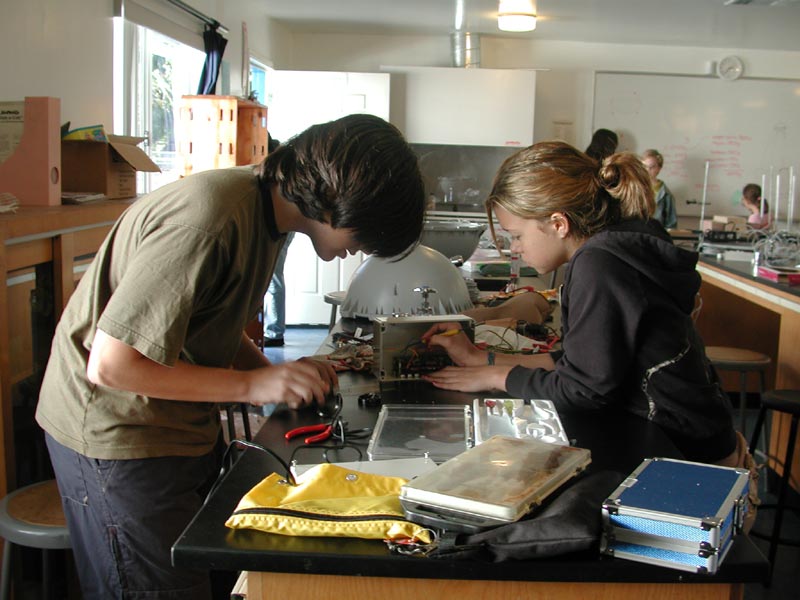 Two Argonautica students work on a temperature sensor. Image credit: NASA/JPL
Two Argonautica students work on a temperature sensor. Image credit: NASA/JPL
January 26, 2006
Over the holidays, high-school sophomore Katie Nance painted her room a cool shade of blue. But she and her schoolmates chose something much bolder for the ocean buoy they recently constructed for an international oceanography program. Their bright red buoy is being launched off the coast of Antarctica this month. If all goes well, the buoy will phone home, thanks to a satellite connection, sending back data on ocean temperatures that will be available to scientists and students around the world.
The buoy project is part of an education program called Argonautica organized by the French space agency, the Centre National d'Etudes Spatiales. With help from JPL, a small group of students from a local French/American school, the Lycee International de Los Angeles, has become the first U.S. participant. The roughly dozen team members were drawn from different classes, ranging in age from 9 to 17. Dr. Mohamed Abid, a senior systems engineer for NASA's Ocean Surface Topography Mission, served as their advisor.
Argonautica is designed to help students learn about the oceans and the role of satellites in oceanography. Participants are given an empty plastic shell from which they have to construct a functional buoy fitted with sensors capable of withstanding harsh ocean conditions plus an anchor to keep the buoy in position as it drifts with the currents.
The first challenge, says seventh grader Turner Edwards, "was figuring out what we wanted to measure. Some wanted to measure the salt in the water, some temperature, and some currents. It was hard to decide."
They had expert help. Abid is the author of a new book titled "Spacecraft Sensors." "We had a number of options," he says, "so we made lists of the pros and cons of our different choices. We finally chose the temperature sensor." The next steps were to understand how the sensors work, test them and make sure they will survive in salt water.
For Nance, the hardest part of the project was all the calculations that needed to be done. "We had to figure out where we were going to put the sensors, how much weight needed to be in the anchor, how many volts we needed for the Argos card -- the satellite transmitter."
Last December after more than a year of work, the Argonautica team completed their buoy with seven temperature sensors and an anchor, which they constructed from plastic pipe and cement. The final step was the red paint. "It looked really good," says Nance, "but there's not much you can do with a buoy."
Isabelle Autissier, a well-known French sailor, is launching the buoy from her ship Ada2. She is on an expedition to retrace the routes of some early Antarctic explorers, including Jean-Baptiste Charcot and Ernest Shackleton. Students will be able to track their buoy and other Argonautica-built buoys from the French space agency's education website and correlate the data they collect with measurements of sea surface height made by the Jason satellite, a joint U.S./French mission.
"This was so much fun to build and put together," says Nance. "We were so proud of ourselves. The best part was working as a team." Edwards agrees, "It was really fun to collaborate. It was nice to come from nothing and do a project from start to finish."
"It's great to see what they can accomplish," says Abid. "Now that they can see what they can do, their expectations get higher. They believe that next time they can build something even more complex."
In France, about 60 school groups participate in Argonautica each year, and the program is expanding in Europe. "We think it is a great program and wanted to bring it to the States," says Annie Richardson, who coordinated the effort in Los Angeles. Richardson is an outreach coordinator at JPL for the Jason mission and the upcoming Ocean Surface Topography Mission. "Many of the Argonautica materials are in French, so we started our pilot project with a small group of students who speak French, but we hope to expand the program to include more schools. We're also developing a pilot Argonautica program for the Boys and Girls Club."
More information about Argonautica can be found at http://www.cnes.fr/html/_98_3112_3147_.php . More information about ocean surface topography is availabe at http:/sealevel.jpl.nasa.gov
Written by Rosemary Sullivant
Media contact: Alan Buis / JPL
(818) 354-0474